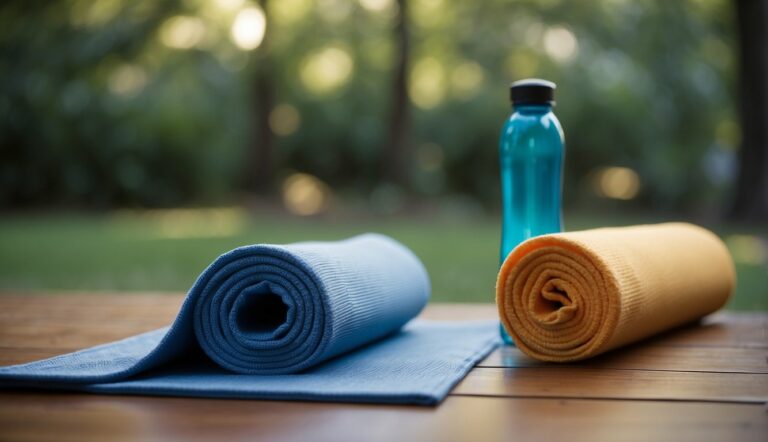Upper Body Warm-Up for Runners – Key Routines, Exercises, and Stretches
When incorporating an upper body warm-up into your running routine, you’re not just preparing your legs but your entire body for the activity ahead.
Warming up your shoulders, chest, and back enhances performance and reduces the risk of injury. Your upper body contributes to your running form and efficiency, making it crucial to activate those muscles before hitting the pavement or trail.
A comprehensive routine should include dynamic stretches and mobility exercises. Start with arm circles to loosen the shoulders, followed by torso twists to engage your core and back. This wakes up the muscles by increasing blood flow and priming your upper body for the demands of running.
Remember, the aim is to get your muscles ready for action, not to exhaust them before you start your main running session. Keep it brief and focused to ensure your body is agile and responsive.
Best Upper-Body Warm-Up Routine for Runners
Preparing your upper body for a run is as crucial as lacing up your shoes. Begin with dynamic stretches to activate your muscles, improve your running form, and reduce the risk of injury.
Arm and Shoulder Activation
Start with arm circles to warm up your shoulders. Perform 10-15 circles forwards, then reverse. This targets your deltoids and biceps. Next, engage your triceps and serratus anterior with shoulder taps. While standing, reach your left hand to tap your right shoulder and vice versa, for 30 seconds.
- Arm Circles
- Forward: 10-15 repetitions
- Backward: 10-15 repetitions
- Shoulder Taps: 30 seconds
Core and Back Engagement
Your core and back keep you balanced and upright during your run. Perform a set of dynamic lunges with a twist over your front leg to engage your core muscles, for 10 reps on each side. Follow with plyometric exercises like mountain climbers, bringing your knees to your chest rapidly for 30 seconds to activate the back and core.
- Dynamic Lunges with Twist
- Each side: 10 repetitions
- Mountain Climbers: 30 seconds
Chest and Arm Expansion
To warm up your chest and complete the arm preparation, execute dynamic push-ups—start from a standard push-up position but add a small lift of your hands off the ground after each push-up. This activates your chest, triceps, and shoulders, and incorporates a light plyometric element. Do 10-15 reps depending on your comfort level.
- Dynamic Push-Ups
- Repetitions: 10-15
This routine is designed to enhance your running performance and safeguard against upper body injuries. Remember, consistency in these warm-up practices contributes significantly to your overall running efficacy.
Is an Upper Body Warm-Up Necessary for Runners?
An upper body warmup is necessary for runners. While running is primarily a lower body activity, the upper body plays a crucial role in maintaining proper form and balance.
Warming up the upper body can help prevent injuries, improve posture, and increase overall efficiency during a run.
The upper body contributes to running by:
- Maintaining Balance: Arms swing in opposition to legs, which helps to stabilize the torso and maintain balance.
- Controlling Breathing: A relaxed and open chest allows for better lung expansion and more efficient breathing.
- Conserving Energy: Efficient arm movement can reduce the overall energy expenditure by minimizing unnecessary motion.
- Propelling Forward: During sprints or uphill running, vigorous arm action can contribute to forward propulsion.
Upper Body Warm-Up Benefits for Runners
Proper upper body warm-up is essential for runners because it enhances movement quality, elevates heart rate, increases blood flow, and prepares muscles and joints for the physical activity ahead.
Elevated Heart Rate: Your warm-up should gradually raise your heart rate, which primes the cardiovascular system for exercise and helps deliver oxygen to your muscles more efficiently.
Improved Blood Flow and Body Temperature: As blood flow increases, the temperature in your muscles rises, leading to improved flexibility and decreased risk of injuries.
Enhanced Mobility: Movement through a full range of motion during a warm-up enhances mobility, particularly in shoulder and elbow joints crucial for running efficiency.
Muscle Activation: Focusing on muscles that are extensively used in running, like the shoulders and upper back, ensures they’re ready for the demands of your workout.
Essential Warm-Up Components
- Dynamic Stretching: Engage in movements that mimic the exercise you will perform, such as arm circles or shoulder rotations, to enhance mobility without risking overstretching.
- Activation Exercises: Use exercises like push-ups or band pull-aparts to activate muscles across the chest, back, shoulders, and arms.
| Warm-Up Component | Purpose |
|---|---|
| Dynamic Stretching | Improves joint rotation and gradually stretches muscles |
| Activation Exercises | Prepares muscles for the workload and stabilizes joints |
Remember, a warm-up isn’t just a preliminary routine; it’s a crucial part of your running success.
Other Important Warm-Up Routines for Runners

Before lacing up for a run, a tailored warm-up routine is essential. It boosts your performance and reduces the risk of injury by preparing your muscles and joints for the activity ahead. Focus on a running-specific sequence followed by an upper-body circuit to ensure your entire body is primed.
Running-Specific Warm-Up Sequence
1. Dynamic Stretches: Engage in 5-10 minutes of dynamic stretches to enhance flexibility and range of motion. Incorporate movements such as:
- Leg swings (forward and side-to-side)
- Walking lunges
- Butt kicks
- High knees
2. Cardio Preparation: Start with a brisk walk, progressing to a light jog for another 5 minutes. Gradually increase your heart rate and loosen up your leg muscles.
| Duration | Activity | Purpose |
|---|---|---|
| 5 min | Dynamic Stretches | Enhance flexibility |
| 5 min | Brisk Walk/Jog | Increase heart rate |
Sample Upper-Body Warm-Up Circuit
1. Resistance Band Drills: Utilize a resistance band for pull-aparts and rowing movements to warm up the shoulders, chest, and upper back. Perform 2 sets of 10-15 reps each. These exercises promote stability and proper running posture.
- Pull-Aparts: Hold the band in front of you and pull it apart horizontally.
- Band Rowing: Attach the band to a fixed point and perform a rowing motion.
2. Bodyweight Exercises: Complete push-ups and inchworms to stimulate the upper body, preparing your muscles for the movements during running.
- Push-Ups: 2 sets of 10-12 reps, focusing on chest and arm strength.
- Inchworms: 2 sets of 5-6 reps, improving shoulder mobility.
Remember, consistency is key in any routine. Maintain proper form and listen to your body. Adjust the intensity and repetitions according to your fitness level and comfort.
Monitoring Warm-Up Intensity

Before you begin your workout, it’s crucial to monitor warm-up intensity. This ensures you elevate your muscle temperature without excessive fatigue, allowing for an optimal performance during your run.
Using Rate of Perceived Exertion
Rate of Perceived Exertion (RPE) is a valuable tool when you don’t have access to heart rate monitors. It’s a subjective measure, on a scale from 1 to 10, where 1 feels like rest and 10 is maximum effort. For an effective warm-up:
- Start easy (RPE 3-4)
- Gradually increase to a moderate level (RPE 5-6)
This helps control tension in your muscles and prevent soreness post-workout. Remember, a study in the Journal of Strength and Conditioning Research suggests at least 10 minutes of continuous activity for a proper warm-up.
Incorporating Rest and Recovery
Rest periods are essential during your warm-up to prevent overworking your heart. Aim for:
- A heart rate that allows for complete sentences when talking (indicator of moderate intensity)
- Short breaks of 30-60 seconds after high-intensity bouts
Incorporating both active and passive recovery phases helps maintain muscle temperature and prevents a build-up of metabolic byproducts that could cause tension or soreness. Your cool down should include lower intensity activities to slowly decrease your heart rate.






